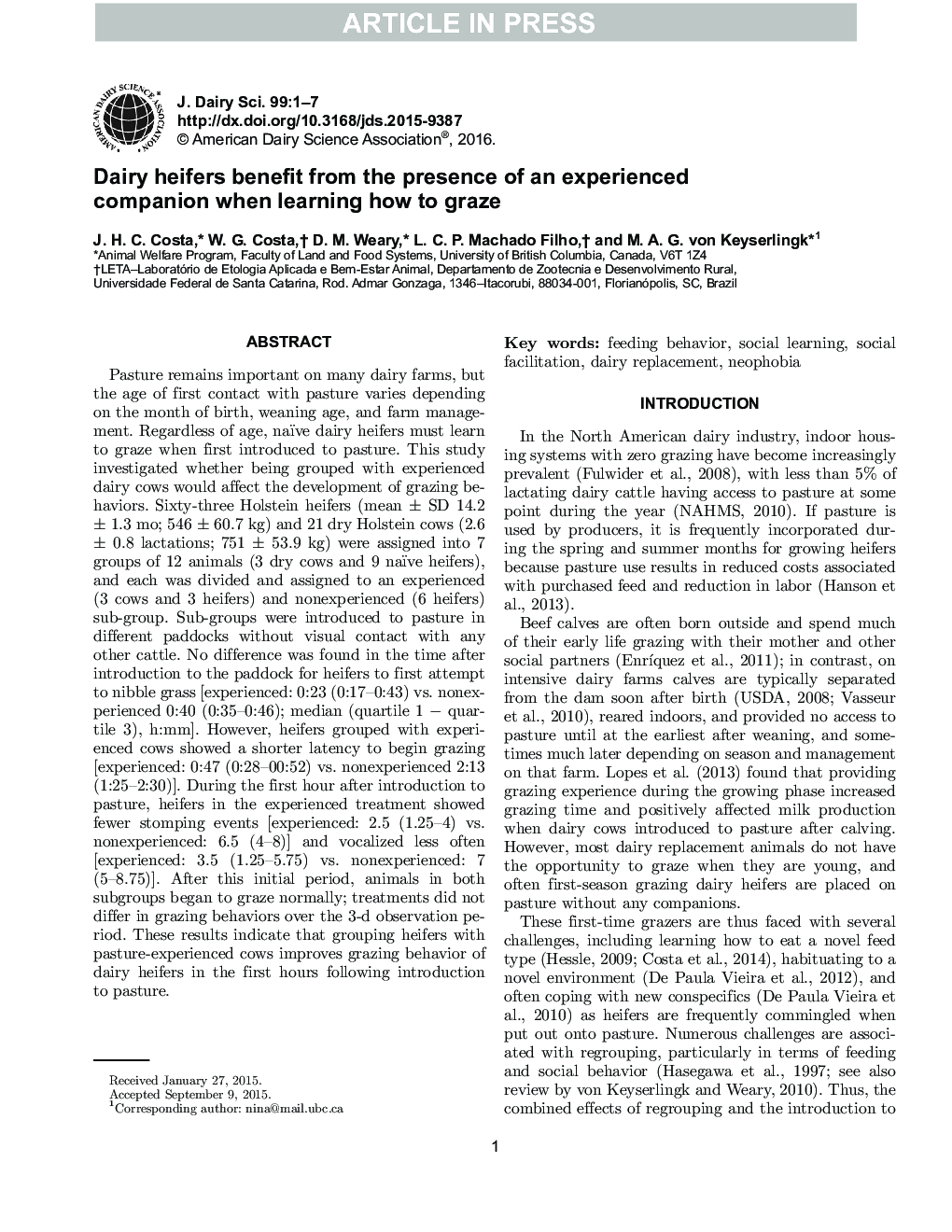| کد مقاله | کد نشریه | سال انتشار | مقاله انگلیسی | نسخه تمام متن |
|---|---|---|---|---|
| 10974043 | 1108021 | 2016 | 7 صفحه PDF | دانلود رایگان |
عنوان انگلیسی مقاله ISI
Dairy heifers benefit from the presence of an experienced companion when learning how to graze
ترجمه فارسی عنوان
تلیسه های لبنی از حضور یک همراه با تجربه در هنگام یادگیری چرت زدن لذت می برند
دانلود مقاله + سفارش ترجمه
دانلود مقاله ISI انگلیسی
رایگان برای ایرانیان
کلمات کلیدی
رفتار تغذیه ای یادگیری اجتماعی، تسهیل اجتماعی، جایگزینی لبنیات، نئوفوبیا،
موضوعات مرتبط
علوم زیستی و بیوفناوری
علوم کشاورزی و بیولوژیک
علوم دامی و جانورشناسی
چکیده انگلیسی
Pasture remains important on many dairy farms, but the age of first contact with pasture varies depending on the month of birth, weaning age, and farm management. Regardless of age, naïve dairy heifers must learn to graze when first introduced to pasture. This study investigated whether being grouped with experienced dairy cows would affect the development of grazing behaviors. Sixty-three Holstein heifers (mean ± SD 14.2 ± 1.3 mo; 546 ± 60.7 kg) and 21 dry Holstein cows (2.6 ± 0.8 lactations; 751 ± 53.9 kg) were assigned into 7 groups of 12 animals (3 dry cows and 9 naïve heifers), and each was divided and assigned to an experienced (3 cows and 3 heifers) and nonexperienced (6 heifers) sub-group. Sub-groups were introduced to pasture in different paddocks without visual contact with any other cattle. No difference was found in the time after introduction to the paddock for heifers to first attempt to nibble grass [experienced: 0:23 (0:17-0:43) vs. nonexperienced 0:40 (0:35-0:46); median (quartile 1 â quartile 3), h:mm]. However, heifers grouped with experienced cows showed a shorter latency to begin grazing [experienced: 0:47 (0:28-00:52) vs. nonexperienced 2:13 (1:25-2:30)]. During the first hour after introduction to pasture, heifers in the experienced treatment showed fewer stomping events [experienced: 2.5 (1.25-4) vs. nonexperienced: 6.5 (4-8)] and vocalized less often [experienced: 3.5 (1.25-5.75) vs. nonexperienced: 7 (5-8.75)]. After this initial period, animals in both subgroups began to graze normally; treatments did not differ in grazing behaviors over the 3-d observation period. These results indicate that grouping heifers with pasture-experienced cows improves grazing behavior of dairy heifers in the first hours following introduction to pasture.
ناشر
Database: Elsevier - ScienceDirect (ساینس دایرکت)
Journal: Journal of Dairy Science - Volume 99, Issue 1, January 2016, Pages 562-568
Journal: Journal of Dairy Science - Volume 99, Issue 1, January 2016, Pages 562-568
نویسندگان
J.H.C. Costa, W.G. Costa, D.M. Weary, L.C.P. Machado Filho, M.A.G. von Keyserlingk,
